The brick building is what remains of the row of shops and Post Office. Depot would have been just to the right.
The field to the left was like the city park. It was the site of carnivals and in the 1960's a Little League baseball field.
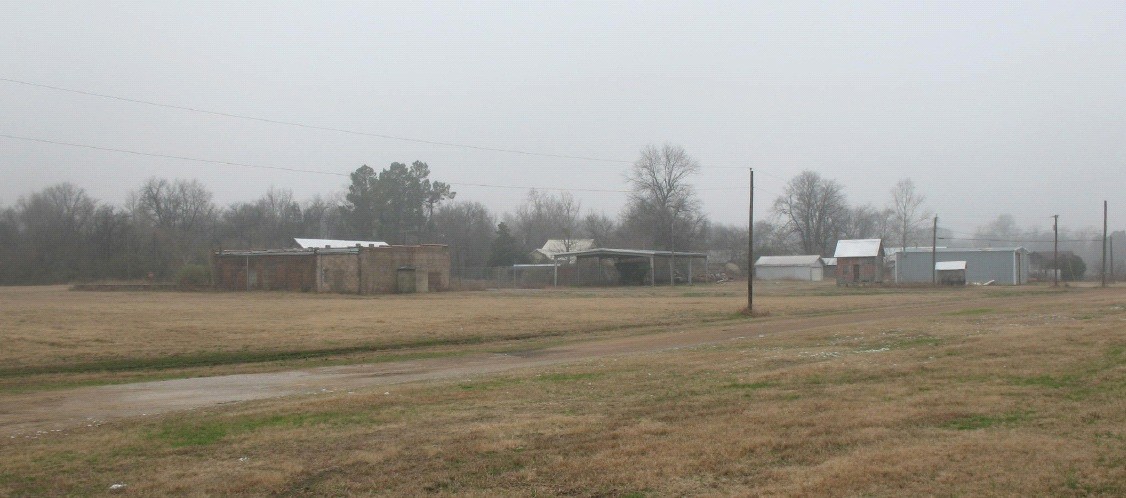
| MENU SELECTION: | The Italian Campaign | At The Front | Books | Armies | Maps | 85th Division | GI Biographies | Websites |
|
Birth, Life, and Death By
Locating the Southern Railway of Mississippi
and
the Yazoo and Mississippi Valley Railroad in relation to the towns of Minter City, Schlater, & Phillip It has never failed – I become interested in a history of something after I move away from that geographic region. It happened with Civil War history. After I moved to Newton Cole
|
|
THE DEPOT Now
I have found the same
happening with the history of railroading in my very small hometown of
As I found information on
the Y&MV I found myself corresponding with an old friend from the
same
town. Marie (Oswalt) Nutt, a woman a few
years younger than me, had lived some of her childhood in the second
story
living quarters of the depot in that small town. Her
dad, Jesse Oswalt, was the station
agent. I decided I wanted to know more
about that depot and the town in the context of the rail lines that ran
through
the area. Marie and I, working from long
distance, decided we wanted to see if we could ‘resurrect’ the building
that
had been torn down in the late 1960s. Marie
furnished a sketch that I expanded into a pencil
drawing. She responded by doing a splendid
drawing
using a computer drafting program. It
turned out that we both had a background in architectural drawing – me
as a
high school teacher and she as a drafter. I
decided to build an HO scale (1:87) model of the depot
that we were
beginning to bring to life, although in reduced size, with the help of
her
memories, some old photos, and research.
As the model evolved we
agreed that the building definitely had what appeared to be a waiting
room or
two. Waiting rooms meant passengers and
passengers meant rail traffic – not just a spur off of a main line to
serve the
oil mill in the town. All my life I only
knew the railroad tracks as a means for the cottonseed oil pressing
operations
to move oil cars, cars filled with ground cottonseed ‘meal’, and cotton
lint to
their destinations. These byproducts of
cotton were used as ingredients in the manufacture of margarine,
cooking oil,
cattle feed, fish food, paints, and explosives. As
a kid I once asked my dad, a shipping clerk at the
mill, why there
was a car marked with Hercules Powder Company on the siding. I was told that they used the small bales of
lint for gun cotton – a key to making explosive powder.
An internet ‘acquaintance’
I met early in my research graciously allowed me to copy photos of
depots of
the 1917 era. The ‘looks’ of the THE RAIL LINES
An old map of 1888 (Fig.1)
shows two lines going through The
SRM ran north from Itta
Bena and served Schlater, Highlandale, and Sunnyside.
Some of the roadbed could have likely run on
the same ground as the future The
1888 map (Fig.1) shows a
short Y&MV line from I
discovered recently that one
of my friends from childhood used to drive his grandfather around the
region
and the grandfather would point out where the railroads had once
crossed the
county roads. That grandfather had said
that he was a telegrapher in 1906 on the Southern (SRM) line. But the odd thing was, the depot was not at
the same location as the one in A
depot to the west of The town, which must have been a pretty impressive thing to behold in about 1917, slowly died. From timetables it can be determined that 6 trains a day ran on the two lines that served the town at that time. There was once a three-story hotel the ruins of which I played in a few times before a concerned citizen put a rope around a main post and tugged with a tractor and the whole thing collapsed. The remains of pilings that once supported the wharf on the river that once served a cotton gin could only be seen in very low water seasons. Story had it that the survivors of a Civil War regiment had to hustle back there after their boat was sunk on the river north of the hastily- built Fort Pemberton near Greenwood. The brick and the tile factories were left as foundations by the late 1950s. The oil mill ceased seed pressing operations in the 1970s which meant there was no longer a need for rail service. The depot was torn down in the late 1960s. Attached is a photo my brother took of what is left of the ‘town’ around New Year’s Day 2009. He was standing where the roadway crossed the old railbed, the road is the one that ran along the east side of the depot, the field was where carnivals once visited, and the buildings are the backs of remnants of a once up-and-coming town. |
| Photo
of Minter City taken in 2009 - View of old town
from the
top of the old YMV railroad bed. The brick building is what remains of the row of shops and Post Office. Depot would have been just to the right. The field to the left was like the city park. It was the site of carnivals and in the 1960's a Little League baseball field.  |
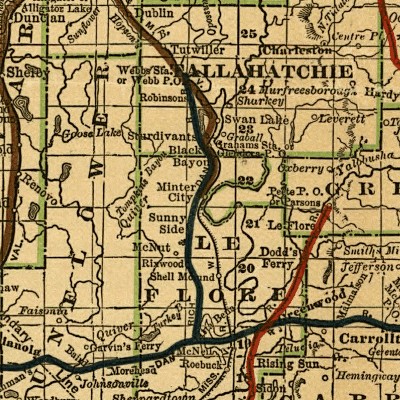 Figure 1.
Map
of 1888
The Y&MV railroads are highlighted in RED and the BROWN colors. The Richmod & Danville railroads are highlighted in BLACK. |
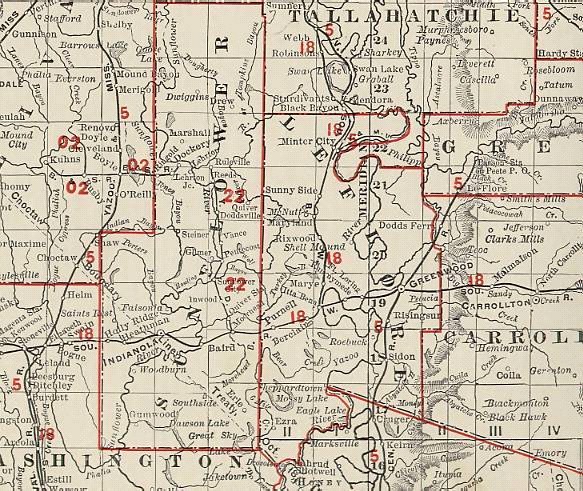
Figure
2. Map of 1895
|
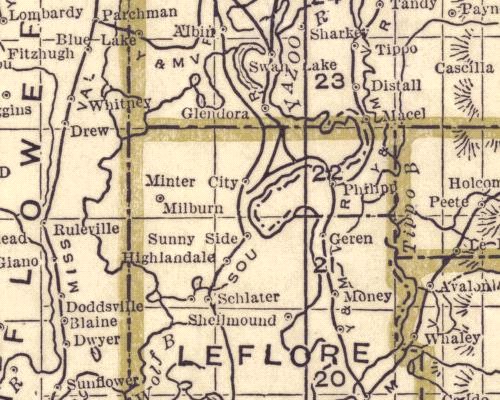 Figure 3. Map of 1919
|
|
SOURCES AND ACKNOWLEDGEMENTS What
was the point? I wanted to delve into
the history of my old town to see what I could find. As
with the study of genealogy, I wanted to know
the history but also wanted to make the trip for the next traveler
along the
path just a little easier. Along that
line, I plan to give copies of this to as many people as might want it. I want them to continue the search. All are free to question my research or
conclusions. Marie and I said, “If we
can’t find it, we’ll put down what we know and let others find it for
us”. Well, at least it would have been
‘found’. History will be lost if it is not
caught and
put on paper as it is found. The sources
listed below have been invaluable in my search. I
list them in general terms so the next traveler can find
materials. Will the internet as we know it
be around in another
half century – or will it be improved? Can
we ask the same thing about the books cited? Like
this old town, history WILL change.
If you have any information on the Yazoo and Mississippi Valley Railroad, contact me at Newton Cole. |
| Figure 4.
Map
of 1934 & 1935 Maps of Minter City from 1934 & 1935 Source: Alabama Maps.us.edu website 4A. Map of Minter City. BM 143 is location of the School. The Y&MV is a spur that goes directly West then turns South. An old rail bed is visible that angles off towards the North. This was the SRM line and is now the location of Hiway 49E. 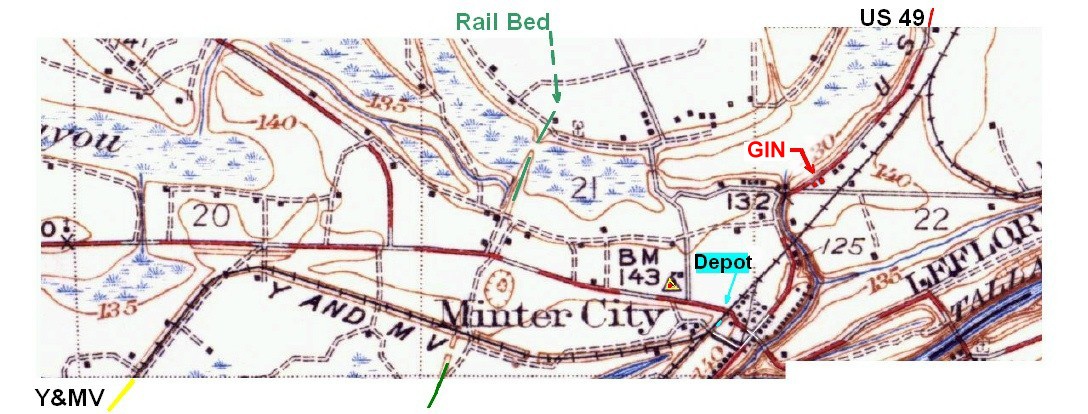 4B. Section of Map showing the Y&MV that continues South from above map and ends at Avent Chapel. In the upper Right corner, next to "City", is the end of the rail that connected with the Minter City Oil Mill until the 1960's.  |
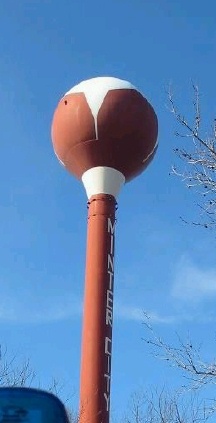 |
Web Links about
Minter City
Frank Pleasants Sturdivant (1917-1996) A resident who lived farmed on the East side of the Tallahatchie River. He was Deputy Group Commanding Officer of 39th Bomb Group. Click for Biography. Newton F. Cole (1917-1992) - A resident for 60+ years. Biography of his service during WW2 with the 85th Infantry Division in Italy. The Bottle Tree Man - A commericial website by Dudley Pleasants. Click for site. |
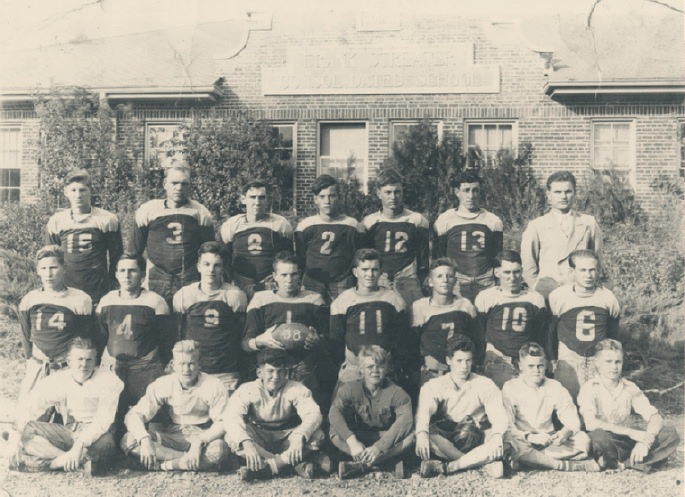 |
| Key Words: History of Yazoon and Mississippi Valley Railroad Y&MV Columbus and Greenville C&G Southern Railway of Mississippi SRM Swiftown Morgan City Glendora Schlater Belzoni |